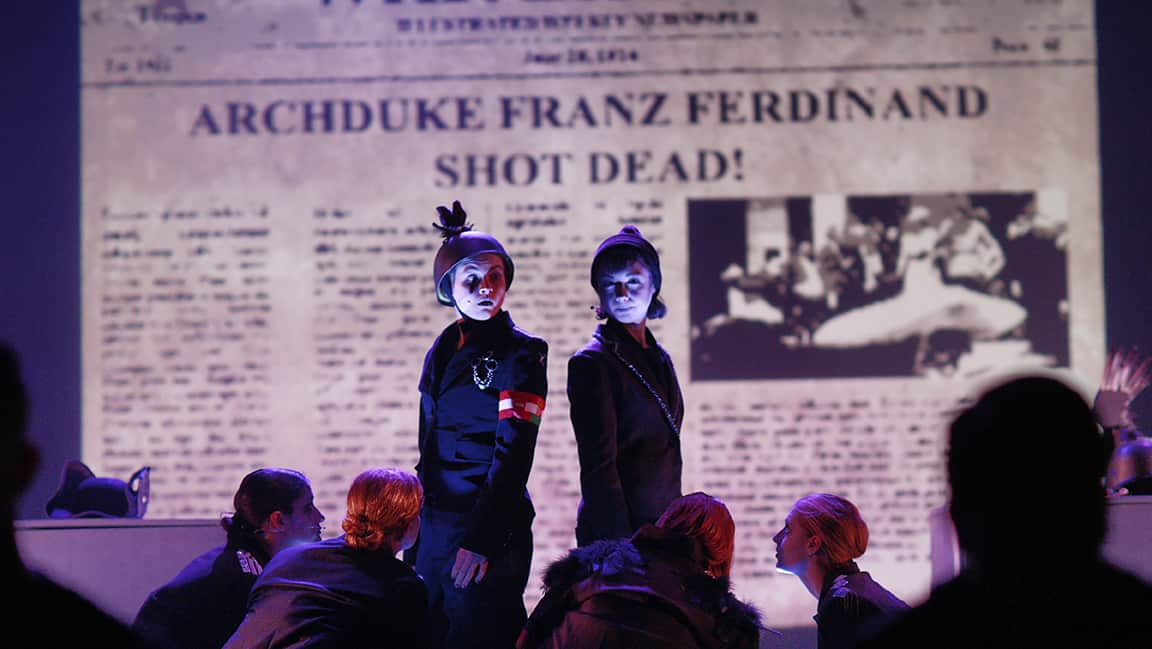Hart House Theatre’s Oh, What a Lovely War! is an adaptation of a 1963 musical created by Joan Littlewood and her theatre ensemble, the Theatre Workshop. Through World War I, it satirizes the phenomenon of war.
Directed by Autumn Smith, Hart House’s rendition of the musical exists within the narrative frame of a video game. This framing is fun and works well. Our narrator throughout is a huge face floating on a black background on multiple screens, telling both the audience and the characters on stage about the facts and events of the war.
Combining projected film sequences with actors, props, stage set, music, and choreographed numbers can be difficult to work out smoothly, but here the screens really lift the performance as a whole. Projections Designer Ian Garrett and Associate Projections Designer Alexandra Caprara did a wonderful job.
The juxtaposition of projected sequences with other theatrical devices at the beginning of the second act is particularly successful. The screens give us details upon details about lethal gas after lethal gas, and it’s impossible to keep those absurdly cruel facts from creeping in under the skin. At one point, the screen turned black and a big flow of yellowish smoke began to fill the stage, seeping into the auditorium. Of course, I knew it wasn’t mustard gas, but there was no way I was breathing in that stuff.
There was also too much rambling with both the several projected sequences as well as parts of the acting. In the opening scene, the initial entry of the six avatars and six gamers, with a projected film in the background, was effective and interesting. However, the ensuing passage, where the avatars became representatives of different European nations standing still on six boxes, reciting in various strong European accents, felt much longer than the 10 or 15 minutes that my clock claims that it took.
Broken English is one of the oldest tricks of comedy, and while a strong French accent will never fail to make an anglophone audience laugh, the other accents used on stage didn’t land the same way. When so much of the comedy rests on this, and so much of this absurd play rests on comic effect rather than narrative, the fun of hearing the German soldiers speak English with a strong German accent does not really work when that passage was just preceded by the same German soldiers singing classical German songs in thick Canadian accents.
The other accents were also not close enough to resemble those of Russia or Serbia. Accents are difficult, but if you pick a play with a first act that rests so heavily on the fun of them, then you need to nail them. And that might mean that you either need bilingual actors or a really good pronunciation coach.
Another challenge for this play is that it has no individual characters for the audience to follow. There are six players who become soldiers within the video game and there are six avatars who embody the different nations.
While the soldiers have individual names, they’re presented all at the same time, so they’re obviously not meant to be heard. And while the avatars represent different nations, each is comical through the same type of pompous attitude, so I quickly forget who said or did what.
Although it rests on the known dramatic arc of World War I, this is a play that is too absurd to give a clear narrative of its own and needs to evoke something else — like humour or emotions — to be engaging. When all the characters are purposely generic, it’s difficult for the play to convey clear emotions. Even the scene of the soldiers laying down their weapons and meeting across the trenches for the Christmas Truce of 1914 left me unusually disengaged.
Taking on a play without individualized characters for the audience to follow, and comic effects based on several accents, certainly is a challenge. What I enjoyed the most, though — apart from the great juxtaposition of screen with sound and stage — was the use of creative new versions of traditional songs.
The most effective moment of the whole play is the very last seconds, when the players take their virtual reality goggles off in relief, and the avatars hiding behind them lean forward to whisper into their ears: “Play again!”


